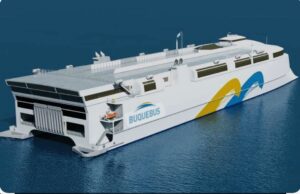An innovative electric ferry, considered the first of its kind worldwide, will start operating between Buenos Aires (Argentina) and Colonia (Uruguay) by the end of 2025. The company Buquebus and the Tourism Ministers of both countries took advantage of the International Tourism Fair (Fitur) 2025 in Madrid to announce the new means of transport that will link both coasts.
The new vessel, named “China Zorrilla” in honor of the iconic Uruguayan actress, will not generate polluting emissions or noise, thus contributing to the protection of the biodiversity of the Rio de la Plata. With a length of 130 meters, it will have capacity for 2,100 passengers and over 220 vehicles, more than doubling the capacity of the company’s current ships, which can carry up to 800 people.
The construction of the ferry is being carried out by Australian shipyards, and its launch is expected to take place in April of this year. Subsequently, the vessel will undergo navigation tests until September, to then be inaugurated in Argentina, where it will be officially presented before starting its regular operations by the end of 2025.
With the entry into service of “China Zorrilla”, Buquebus will retire two diesel vessels from operation, significantly reducing the company’s polluting emissions and moving towards a more sustainable transportation system.
During the presentation event, the Minister of Tourism of Argentina, Daniel Scioli, highlighted the commitment to sustainability represented by the ferry, describing it as “a symbol of integration and brotherhood between Uruguay and Argentina.” Eduardo Sanguinetti, Minister of Tourism of Uruguay, emphasized the relevance of the project as an example of innovation and environmental care.
 This is the electric ferry that will connect Argentina with Uruguay. Photo: Social networks.
This is the electric ferry that will connect Argentina with Uruguay. Photo: Social networks.
From electric ferries to sustainable buses
The incorporation of this electric ferry is just one more step towards sustainability, given that the company implementing it already has a fleet of latest-generation buses, whose engines feature maximum ecological efficiency technology.
These engines are characterized by achieving a more efficient combustion capable of increasing power without exceeding emissions and fuel consumption, making them more sustainable. The “China Zorrilla” emerges as a milestone in the transition to sustainable maritime transport, reinforcing the ties between two neighboring countries and demonstrating the potential of clean technologies in large vessels.
Have you visited our YouTube channel? Subscribe now!

